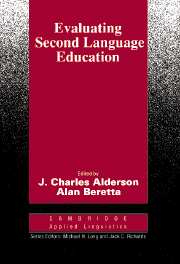Book contents
- Frontmatter
- Contents
- List of contributors
- Series editors' preface
- Acknowledgements
- Introduction
- I EVALUATION OF LANGUAGE EDUCATION: AN OVERVIEW
- II CASE STUDIES OF CURRENT PRACTICE
- Chapter 1 Insiders, outsiders and participatory evaluation
- Chapter 2 Evaluating a program inside and out
- Chapter 3 The ‘independent’ evaluation of bilingual primary education: a narrative account
- Chapter 4 Issues in evaluating input-based language teaching programs
- Chapter 5 Program-defining evaluation in a decade of eclecticism
- Chapter 6 Evaluation of classroom interaction
- Chapter 7 Moving the goalposts: project evaluation in practice
- Chapter 8 What can he learned from the Bangalore Evaluation
- III GUIDELINES FOR THE EVALUATION OF LANGUAGE EDUCATION
- Appendices
- Author Index
Chapter 7 - Moving the goalposts: project evaluation in practice
from II - CASE STUDIES OF CURRENT PRACTICE
Published online by Cambridge University Press: 05 October 2012
- Frontmatter
- Contents
- List of contributors
- Series editors' preface
- Acknowledgements
- Introduction
- I EVALUATION OF LANGUAGE EDUCATION: AN OVERVIEW
- II CASE STUDIES OF CURRENT PRACTICE
- Chapter 1 Insiders, outsiders and participatory evaluation
- Chapter 2 Evaluating a program inside and out
- Chapter 3 The ‘independent’ evaluation of bilingual primary education: a narrative account
- Chapter 4 Issues in evaluating input-based language teaching programs
- Chapter 5 Program-defining evaluation in a decade of eclecticism
- Chapter 6 Evaluation of classroom interaction
- Chapter 7 Moving the goalposts: project evaluation in practice
- Chapter 8 What can he learned from the Bangalore Evaluation
- III GUIDELINES FOR THE EVALUATION OF LANGUAGE EDUCATION
- Appendices
- Author Index
Summary
Introduction
In this chapter I discuss a KELT (Key English Language Teaching) Project at Hasanuddin University, Indonesia. The discussion falls into two major parts. In the first, the history of the KELT Project is chronicled in some detail. Then, in the second, observations are made on the evaluation of the Project.
In the first part, I have adopted a roughly chronological approach. What began as a Project dealing with the pre-departure language needs of university staff gradually came to concentrate exclusively on the development of the Risking Fun study skills programme for first year undergraduates. What emerges is evidence that changes in the Project's objectives came about as the consequence of four different forces. Furthermore, there appears to have been an approximate correlation between the chronological development of the Project and the occurrence of these four different forces.
Now, if it is indeed the case that the fundamental nature of the Project changed over time, then of course it becomes very difficult to know how to evaluate the Project as a whole. As a project changes and its objectives are modified, so, inevitably, the criteria by which it can be evaluated must also change. These are questions which are discussed in the second part of the chapter.
The history of the Project
Prehistory
The Project functioned for just under six years, from October 1980 until the middle of 1986.I was involved in the Project from its beginning until October 1984.
- Type
- Chapter
- Information
- Evaluating Second Language Education , pp. 222 - 249Publisher: Cambridge University PressPrint publication year: 1992
- 3
- Cited by



